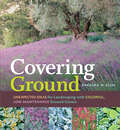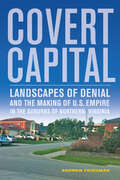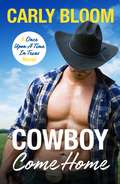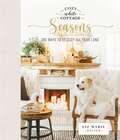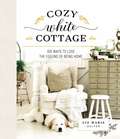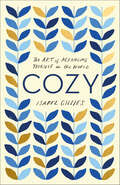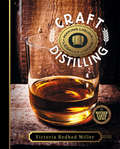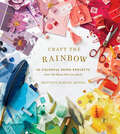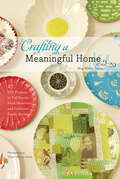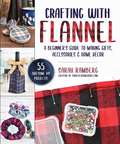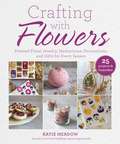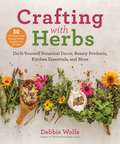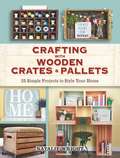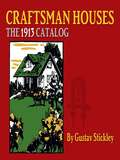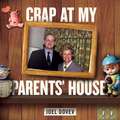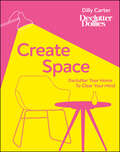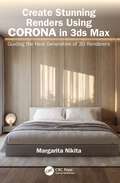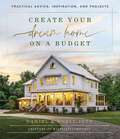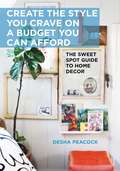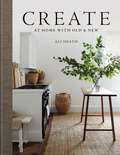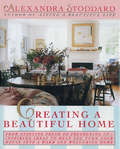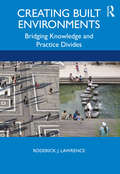- Table View
- List View
Covered Bridges in China
by China Highway &Transportation SocietyThis book is the first comprehensive work on Chinese covered bridges study, covering fields of human geography, historical buildings, and transportation. It includes more than 300 covered bridges of ancient and modern China, researching and analyzing their historical evolutions, architectural technologies and aesthetic values. And it, for the first time, divides Chinese covered bridges into “six covered bridge belts” and fills the academic gaps. This book presents an informative and splendid tour into covered bridges, illustrated and full of humanist consciousness. It targets on audience who works in transportation, human geography, historical buildings and Chinese traditional culture with its significant value both in academy and art.
Covering Ground: Unexpected Ideas For Landscaping With Colorful, Low-maintenance Ground Covers
by Barbara W. EllisGround covers are a pretty and practical way to bring diversity, elegance, and durability to open sweeps of lawn. Give your landscape a vibrant new palette that is both sustainable and low-maintenance through plantings of herbs, shrubs, mosses, and more. Barbara W. Ellis provides a variety of full-color lawn designs and professional planting advice to get you started. You’ll be amazed as your ordinary lawn transforms into a striking display of color and texture.
Covert Capital: Landscapes of Denial and the Making of U.S. Empire in the Suburbs of Northern Virginia (American Crossroads)
by Andrew FriedmanThe capital of the U.S. Empire after World War II was not a city. It was an American suburb. In this innovative and timely history, Andrew Friedman chronicles how the CIA and other national security institutions created a U.S. imperial home front in the suburbs of Northern Virginia. In this covert capital, the suburban landscape provided a cover for the workings of U.S. imperial power, which shaped domestic suburban life. The Pentagon and the CIA built two of the largest office buildings in the country there during and after the war that anchored a new imperial culture and social world. As the U.S. expanded its power abroad by developing roads, embassies, and villages, its subjects also arrived in the covert capital as real estate agents, homeowners, builders, and landscapers who constructed spaces and living monuments that both nurtured and critiqued postwar U.S. foreign policy. Tracing the relationships among American agents and the migrants from Vietnam, El Salvador, Iran, and elsewhere who settled in the southwestern suburbs of D.C., Friedman tells the story of a place that recasts ideas about U.S. immigration, citizenship, nationalism, global interconnection, and ethical responsibility from the post-WW2 period to the present. Opening a new window onto the intertwined history of the American suburbs and U.S. foreign policy, Covert Capital will also give readers a broad interdisciplinary and often surprising understanding of how U.S. domestic and global histories intersect in many contexts and at many scales.American Crossroads, 37
Cowboy Come Home: A steamy, wild ride for any modern romance lover! (Once Upon A Time In Texas #2)
by Carly BloomCowboy Come Home is Carly Bloom's new sexy Western romance. Perfect for fans of Harper Sloan, Kelly Elliott, Diana Palmer, Jennifer Ryan and Jessica Clare.Welcome to Big Verde, Texas, where a love-'em-and-leave-'em cowboy faces his greatest challenge yet - the woman he left behind. 'As always, Bloom's writing is hilarious, steamy, and really sweet' 5* review 'Honestly, I didn't want this book to end' 5* review 'Cowboy Come Home, just like its predecessor, is a romance for modern readers....I cannot wait for the next one!' 5* reviewSome cowboys aren't cut out to be Prince Charming - and Claire Kowalski knows that better than anyone. She gave her heart to Ford Jarvis two years ago, yet that didn't keep him from disappearing into the sunset. Now that he's back in Big Verde, Texas, she's determined not to make the same mistake twice. But the ruggedly sexy cowboy still knows how to push all her buttons, and avoiding him is nearly impossible when she needs his help.Ford didn't plan on returning home - ever - but when he hears that the Kowalski ranch is in trouble, he hightails it back to town. He's not eager to be reminded of the life he can never have, but his time in Big Verde is only temporary. He'll stay long enough to get the ranch up and running, then hit the road again. But when Ford finds out the new foreman he's training is Claire, still as stubborn and beautiful as ever, this cowboy is going to have to decide what matters most - repeating the mistakes of the past or fighting for a future with the only woman he's ever loved.*Includes Rocky Mountain Cowboy, a novella by Sara Richardson*Look out for more Once Upon a Time in Texas westerns, including Big Bad Cowboy, out now!Praise for Carly Bloom and Big Bad Cowboy:'Sexy, smart, sensational!' Lori Wilde, New York Times bestselling author 'Big Bad Cowboy is sweet and sexy!' Jennifer Ryan, New York Times bestselling author 'Fans of Susan Elizabeth Phillips will delight in this funny, optimistic, quirky contemporary' Publishers Weekly, starred review
Cozy Minimalist Home: More Style, Less Stuff
by Myquillyn SmithMore Style, Less StuffCozy Minimalism isn’t about going without or achieving a particular new, modern style. Nope. It’s simply a mindset that helps you get whatever style YOU LOVE with the fewest possible items.You want a warm, cozy, inviting home, without using more resources, money, and stuff than needed. Why use more if you don't have to?In Cozy Minimalist Home, accidental stylist and bestselling author Myquillyn Smith guides you step by step on making purposeful design decisions for your home. You'll have the tools to transform your home starting with what you already have, and using just enough of the right furniture and decor to create a home you're proud of in a way that honors your personal priorities, budget, and style. No more fretting when it comes to decorating your house! In Cozy Minimalist Home, Myquillyn Smith helps youRealize your role as the curator of your home who makes smart, style-impacting design choicesFinally know what to focus on, and what not to worry about when it comes to your homeDiscover the real secret to finding your unique style—it has nothing to do with those style quizzesUnderstand how to find a sofa you won't hate tomorrowDeconstruct each room and then re-create it step by step with a fail proof processCreate a pretty home with more style and less stuff—resulting in backwards decluttering!Finish your home and have it looking the way you've always hoped so you can use it the way you've always dreamed After reading Myquillyn's first book, The Nesting Place, women everywhere were convinced that it doesn’t have to be perfect to be beautiful and they found real contentment in their homes. But how does a content imperfectionist make actual design decisions?Cozy Minimalist Home is the answer to that question. Written for the hands-on woman who'd rather move her own furniture than hire a designer, this is the guidance she needs to finish every room of her house. With people, priorities and purpose in mind, anyone can create a beautiful home that transcends the trends.A pretty home is nice, but a Cozy Minimalist home goes beyond pretty and sets the stage for connection, relationship, and rest.
Cozy White Cottage Seasons: 100 Ways to Be Cozy All Year Long
by Liz Marie GalvanWhether you want to create a cozy winter wonderland in your living room, a blooming summertime welcome on your deck, or an autumn refuge by your fireplace, Liz Marie Galvan&’s Cozy White Cottage Seasons gives you the inspiring photos, DIY ideas, and fun recipes you need to feel at home on any budget and in every season.Do-it-yourself interior designer and popular blogger Liz Marie Galvan helps you create space to snuggle up, stretch out, or kick back at home so you can focus on what matters most during the holidays and every day. Following the popularity of Cozy White Cottage, Cozy White Cottage Seasons is a beautiful, full-color photography holiday lifestyle book with easy-to-do, practical tips to make your home a welcome haven—from New Year&’s Day to spring, summer, fall, and all the way through Christmas.Cozy White Cottage Seasons equips you to:Create cozy celebrations, traditions, and memories indoors and outRepurpose furniture and decor for every seasonCultivate your flair for vintage, modern, farmhouse, or a unique style all your ownDesign a hot cocoa bar—and make other seasonally cozy recipesStore and manage holiday clutterAnd so much more!In addition, you&’ll find fun ideas to celebrate and decorate for: Christmas Thanksgiving Halloween Fourth of July Father&’s Day and Mother&’s Day Easter Valentine&’s Day And any special gatheringsCozy White Cottage Seasons is a great gift for Christmas, birthdays, and Mother&’s Day or as a beautiful yet practical housewarming gift.A cozy enthusiast living in an 1800s farmhouse, Liz&’s design tips and wisdom have been featured on the TODAY show, Better Homes and Gardens, and Country Living. With decorating tips, fun family traditions, and doable ways to make your home inviting in every season, Liz helps you create a beautiful living space and a grateful heart all year long.Look for Liz's other cozy home décor book full of DIY inspiration, Cozy White Cottage.
Cozy White Cottage: 100 Ways to Love the Feeling of Being Home
by Liz Marie GalvanWhether you live in a country farmhouse or an urban apartment, you will find inspiration for every room in your home. Come cozy up with your creativity and Liz's welcoming voice so you can love the feeling of being at home. In this beautiful book of house and garden photography and DIY inspiration, popular blogger Liz Marie Galvan shares a hundred tips and tricks, budget-friendly hints, and project how-tos to make every room in your house feel like a home you love. Each month hundreds of thousands of readers find design inspiration and DIY ideas on Liz's blog, where Liz shares stories of life with her veteran husband, their 1800s Michigan farmhouse, and the home décor boutique she co-owns.In Cozy White Cottage, Liz offers her best home décor and design tips to help you create a home you'll love coming home to. You'll love Liz's real-life, easy, and affordable ideas to get the most out of your home and discover things like:The passion and productivity that can pour out of an inspiring, functional workspace or officeThe conversation and connection that flow out of a warm, well-arranged living roomThe thoughtful hospitality that can welcome guests, be it for a cup of coffee or an overnight stayThe rejuvenation that can happen when we have quiet spaces for reading, prayer, and restThe calming routines and rituals that we can implement into our spaces and our livesThe laughter, joy, and learning that can occur in adorable, functional playroomsThe life-giving power that beats out of the heart of our homes, the kitchen Cozy White Cottage offers inspiration for every style, from country farmhouse to urban apartment. Come cozy up with your creativity and Liz's welcoming voice so you can love the feeling of being at home.
Cozy: The Art of Arranging Yourself in the World
by Isabel Gillies“Coziness is a state of mind” for the New York Times–bestseller of Happens Every Day, who has written a lifestyle guide as “a companion to Marie Kondo” (New York Times Book Review).When we talk about being cozy, most of us think of a favorite sweater or a steaming cup of tea on a rainy day. But to Isabel Gillies, coziness goes beyond mere objects. To be truly cozy, she argues, means learning to identify the innermost truth of yourself and carrying it into the world, no matter your environment.Starting when she was young, Gillies has gradually learned the art of creating a life where you feel safe, steadied, and at home in the world. In Cozy Gillies shows readers that true ease stems from opportunities to feel that we are part of something bigger than ourselves.Simple choices can make a hectic life or an uncomfortable situation just a little more comfortable—you just have to know what to do. Gillies offers a new way of occupying the spaces we live in. Written with profound warmth and featuring hand-drawn illustrations, this wise, necessary book is call to action for each of us to begin living a more intimate and authentic life.“Beautifully written with warmth and heart.” —Charles Duhigg, New York Times–bestselling author of The Power of Habit “Gillies blends first-person essays and travelogues, recipes, and tips to show that coziness [is] a way of looking at the world in a new light.” —Real Simple“A mashup of manifesto, lifestyle guide, memoir, observation, recipes. . . . Put it on the shelf next to your copy of The Little Book of Hygge, Marie Kondo, and The Happiness Project.” —Goop
Craft Distilling
by Victoria Redhed MillerMany people have experienced great success making their own beer or wine at home. In recent years a number of hobbyists have become interested in making distilled spirits. However, distilled spirits are more complicated to produce, and the process presents unique safety issues. In addition, alcohol distillation without a license is illegal in most countries, including the United States and Canada. From mashing and fermenting to building a small column still, Craft Distilling is a complete guide to creating high-quality whiskey, rum and more at home. Experienced brewer, distiller, and self- reliance expert Victoria Redhed Miller shares a wealth of invaluable information including: Quality Spirits 101: Step-by-step recipes and techniques Legal Liquor: An overview of the licensing process in the United States and Canada Raising the Bar: Advocacy for fair regulations for hobby distillersThis unique resource will show you everything you need to know to get started crafting top-quality spirits on a small scale - and do it legally. Sure to appeal to hobbyists, homesteaders, self-sufficiency enthusiasts, and anyone who cares about fine food and drink, Craft Distilling is the ideal offering for independent spirits. Victoria Redhed Miller is a writer, photographer and homesteader who lives on a forty-acre off-grid farm in northwest Washington State with her husband David. She strives to enhance her family's self-reliance through solar energy, gardening, food preservation, raising heritage poultry, blacksmithing, and other traditional skills Victoria is the author of Pure Poultry: Living Well with Heritage Chickens, Turkeys and Ducks.
Craft the Rainbow: 40 Colorful Paper Projects from The House That Lars Built
by Brittany Watson JepsenThe popular craft designer and lifestyle blogger shares a rainbow of new project ideas—all using the creative power of paper.What began as a project collection and viral Instagram hashtag (#CrafttheRainbow) has become an inspiring book featuring all-new paper project ideas. Learn how to make playful party decorations, luscious flowers, amazing cards, and sophisticated wreaths, garlands, centerpieces, and more than you can imagine. Brittany Watson Jepsen is known for the unusually imaginative and amazingly beautiful designs she creates for her website and host of clients (including Anthropologie). In Craft the Rainbow, Jepsen walks readers through the easy basics of transforming simple paper—including tissue, crepe, cardstock, leaves of books, and vintage and recycled paper—into vibrant, fanciful, handmade projects suitable for every occasion.
Crafting a Meaningful Home: 27 DIY Projects to Tell Stories, Hold Memories, and Celebrate Family Heritage
by Meg Mateo IlascoTwenty-seven projects to personalize your living space: “This heartwarming craft book reminds me why I love decorating my own home so much.” —Lena Corwin, author of Printing by HandHome is our refuge and a part of our identity. These DIY projects let us craft a space that celebrates who we are and where we’ve been. In Crafting a Meaningful Home, Meg Mateo Ilasco shares twenty-seven projects that tell personal stories and celebrate heritage, all easily created on a budget. Learn how to decoupage a plate with photos of a best friend; silkscreen upholstery with folk motifs; artfully display love notes; sew a teepee from a vintage quilt top; create family silhouettes for a festive banner; and much more. Contributed by a cast of well-known designers from across the country, the projects are, at once, nostalgic, sentimental, and modern. Clear instructions are easy to follow, even for beginning crafters.
Crafting with Flannel: A Beginner's Guide to Making Gifts, Accessories & Home Décor
by Sarah RambergAdd a flannel flair to every corner of your life with this creative collection of DIY crafts: pillow covers, tote bags, fabric pumpkins, coasters, bookmarks, and more! Very few fabrics elicit such a cozy feeling as flannel. With its universal appeal and inexpensive cost, flannel is a terrific medium to create new décor for your home, a unique accessory to wear, or a thoughtful gift to give. Featuring more than fifty easy-to-follow tutorials, Crafting with Flannel is full of creative and inspired crafts appropriate for all ages and skill levels. From quick and easy projects that take just minutes to make, to more robust ideas on a larger scale, the step-by-step instructions inside this book will help you create: Handmade giftsPersonalized accessoriesCozy home décor Festive holiday trimmingsAnd so much more! Plaid never goes out of style, so channel the flannel and start crafting with it!
Crafting with Flowers: Pressed Flower Decorations, Herbariums, and Gifts for Every Season
by Katie MeadowMake Your Own Unique, Whimsical Gifts and Treats Inspired by Nature's Beauty! Everyone could add a bit of brightness to their daily life. This book will teach you how to make a wide range of floral crafts, and help you truly connect to nature and the magical woodlands. The crafts are organized seasonally, so you can happily craft all year round and always have gifts at the ready. Beginning with lovely spring crafts using bright, beautiful flowers, summer crafts aimed more at weddings, celebrations, and festivals, such as dried flower button holes and pressed flower nail art. In autumn we move to more cozy self‑care crafts like bath salts and candles, and winter includes crafts that are handmade gift ideas such as pressed flower cards and ornaments. Crafts include: Crystallized edible flowers to top cakes and cupcakesBotanical wax sachets to keep your closet freshly scentedPink rose petal bath bombsBeautiful botanical framesFlower-infused cookies and chocolates
Crafting with Herbs: Do-It-Yourself Botanical Decor, Beauty Products, Kitchen Essentials, and More
by Debbie WolfeCapture the beauty, fragrance, and power of herbs in these delightful crafts for home and garden. Why craft with herbs? They're easy to grow, beautiful, fragrant, full of health benefits, and are incredibly versatile! Herbs are best known for their medicinal and culinary uses, but there&’s so much more you can do with them. From spray disinfectants to wreaths and garlands, custom herb salts to homemade skincare products, there's something here for every room of your house—and everyone on your gift list! Learn how to make beautiful and useful items such as:Smudge SticksHerb SachetsHanging Herbal SwagNatural ConfettiHerbal Cleaning VinegarsHerb salts (with recipes for different blends)Herbal Teas Compound Herb ButterLavender Neck WrapSimple Herbal BalmAnd much more!In addition to the crafts, learn how to grow, prune, harvest, dry, and store your favorite herbs. Woven throughout are helpful tidbits on the wellness properties and history of herbs.Create useful crafts that will beautify your home and make wonderful DIY gifts!
Crafting with Wooden Crates and Pallets: 25 Simple Projects to Style Your Home
by Natalie WrightYou don't have to be a carpenter or a home improvement expert to undertake these twenty-five projects, which combine elements of crafting and woodworking. Step-by-step instructions, accompanied by full-color photos, explain how to build surprisingly simple, attractive, and inexpensive indoor and outdoor furniture. The common denominators in these fun-filled and practical projects are ordinary wooden crates and pallets, which are readily available at craft and home improvement stores, vintage shops, and online. The first project demonstrates how easy it is to build your own crate from scratch. Indoor projects include storage shelves, nightstands, a bookshelf, an upholstered footstool, a benche, a side table, a desk, and storage units. Stepping outside, the projects feature a do-it-yourself children’s lemonade stand and a planter box. Several of the projects are equally functional indoors and out: decorative pieces, a game, a sign, a rolling cart, a toolbox, and other handy and playful items. The ease and simplicity of the projects make them a great way for novices — especially kids — to discover the pleasures and satisfaction of crafting and workworking.
Craftsman Houses: The 1913 Catalog
by Gustav StickleyGustav Stickley pioneered a form of architecture based on beauty, simplicity, utility, and organic harmony. This inexpensive reprint of a very rare catalog testifies to the enduring charm of his designs. It comprises numerous architectural drawings and photographs of Mission-style homes, including floor plans and descriptive text."Planned for comfort, convenience, and economy," each of these homes features a simple arrangement of rooms and sturdy structural features. Combining good taste with practicality, they offer openness for common household life, as well as sufficient seclusion for privacy. Models range from a two-family house of cement or stucco to a nine-room cottage of brick and shingles and a seven-room country bungalow. Restorers of old houses, preservationists, and students of American architectural history will prize this well-illustrated treasury of authentic plans and details.
Crap at My Parents' House
by Joel DovevAn illustrated celebration of the trinkets and tchotchkes that accumulate over a lifetime—and turn ordinary family homes into weird museums . . . Deer-hoof bottle openers. Grizzly bear toilet paper holders. A copy of Sports Illustrated from 1983 with Hulk Hogan on the cover. You never know what you might find lurking at your parents&’ house. Standup comic and blogger Joel Dovev has made it his personal quest to compile a catalog of the useless, tacky, and utterly bizarre items that moms and dads not only acquire in the first place, but refuse to throw out, all for reasons unbeknownst to their kids. If you&’ve ever helped with cleaning and organizing efforts—or just opened up a junk drawer or a box in the basement during a visit home—you&’re sure to recognize the feeling of stumbling across treasures such as these and asking yourself, &“Why?&” Packed with photos and humorous observations, Crap at My Parents&’ House is a very special journey sure to provoke a mixture of tender nostalgia . . . and head-shaking bafflement.
Create Space: Declutter your home to clear your mind
by Dilly CarterCut the clutter, live better with less, give yourself headspace, and enjoy life more. Create Space shows you how taking steps to clear and simplify your living space can also clear your mind, improve your relationships, and enhance your well-being. This room-by-room guide to organizing and decluttering your home is packed with ideas, advice, tips, and techniques that are practical and functional as well as beautiful. Turn chaos into calm with step-by-step methods that you can adapt and sustain for your own needs.When you stop allowing your life to revolve around things that don't matter, you instantly gain energy to focus on the things that do. Reclaim your space, your time, and your mind right now, to reorganize your living space into a place of sanctuary.
Create Stunning Renders Using Corona in 3ds Max: Guiding the Next Generation of 3D Renderers
by Margarita NikitaThis book is a comprehensive step‑by‑step guide tailored for designers seeking to elevate their visualization skills using the powerful combination of Corona 11 in 3ds Max 2024.It begins by acquainting readers with the 3ds Max interface and fundamental commands, ensuring a solid foundation for navigating the software. Readers will be guided through the process of assigning Corona and fine‑tuning rendering settings, setting up cameras, and mastering both natural and artificial lighting techniques within their scenes.It then progresses to the creation of materials, their application to the scene, and the utilization of Corona’s libraries and presets for efficiency. The potentials of Corona are detailed using a bedroom scene as an example. This practical guide demystifies the complexities of 3D rendering without delving into modeling techniques.With design studios increasingly incorporating 3D renderings into their proposals, Create Stunning Renders Using Corona in 3ds Max: Guiding the Next Generation of 3D Renderers serves as an invaluable resource for professionals and aspiring renderers alike. It aspires to contribute significantly to the evolution of the next generation of 3D rendering artists, making it an essential companion for those eager to master the art of photorealistic renderings in the dynamic landscape of 3ds Max and Corona 11.
Create Your Dream Home on a Budget: Practical Advice, Inspiration, and Projects
by Noell Jett Daniel JettHave you always wanted to transform your house into the home of your dreams but you're not sure where to begin? Create Your Dream Home on a Budget will equip you with the motivation and how-to you need to create living spaces you love on a budget you can afford. With inspiration from beautiful photos, DIY projects, and foundational building and renovation concepts, you'll be on your way to creating your own dream home.Seasoned home-renovation experts and TikTok stars Daniel and Noell Jett (@JettSetFarmhouse) know a thing or two about building gorgeous homes with cost-effective tips and tricks. You'll learn how to add functionality, beauty, and charm to each room of your home--including ideas for outdoor spaces--whether you're renovating or building from the ground up! In Create Your Dream Home on a Budget, the Jetts provide:Steps to modernize your home without a major renovationDIY expertise for laying tileTips to install your own closet system to stay organizedInstructions to add or replace new features such as lighting fixturesAnd so much more! Every week, Daniel and Noell Jett inspire millions of followers on their own home makeover journeys. You'll complete your unique do-it-yourself projects and create a foundation of beauty for your own living spaces in no time! Create Your Dream Home on a Budget makes the perfect self-purchase, housewarming present, birthday gift, Mother's Day read, or holiday gift.
Create the Style You Crave on a Budget You Can Afford: The Sweet Spot Guide to Home Decor
by Desha PeacockAn Inspiring, Eclectic, and Practical Guide to Creating Your Dream Living Space, on a BudgetIn this unique and hip home decor style guide, you will find the inspiration to explore your own sense of style, discover the essence of what makes your home feel good to you, and learn how to mix vintage, modern, and thrift store finds to create the eclectic look you crave on a budget you can afford.Create the Style You Crave on a Budget You Can Afford is different from most decorating books. While filled with eye candy, it also explores how creatively expressing yourself in your home and garden helps you create the life you really want to live. No matter your budget or style, you'll be inspired by stories of everyday women with busy lives and limited budgets who have infused personal values, meaning, and style into making their own "sweet spot" homes. Instead of feeling overwhelmed, you will feel inspired as you see how other women like you have done it, with style-developing tools such as mood boards. With the help of loads of resources, both online and off, you can create an environment that reflects who you are and what you want, so you can draw more of that into your life.
Create: At Home with Old & New
by Ali HeathSome of the most exciting interiors around are those that layer vintage and antique finds with select contemporary pieces. In Create, interior stylist and journalist Ali Heath encourages you to think imaginatively about how to bring together old and new at home - introducing individuality and interest, while incorporating the need to decorate more sustainably.Following on from the success of her first book Curate, Create is a visual feast divided into three engaging and informative chapters. Establishing Your Style will fire your imagination, while Adding the Magic considers various decorating elements, including pattern and texture, curiosities and collections, furniture and furnishings, art and display, and lighting. In Creative Spaces the homes of a maverick group of 10 antique dealers and interior designers are shared - offering a mix of pared-back neutral homes and more colourful spaces -,providing a fresh new take on artfully combining old and new. The book is full of insightful advice from experts and gives readers a valuable sourcebook to return to for inspiration. With glorious photography, original drawings and break-out ideas pages, Create will give you the confidence to nurture a home you love - one that celebrates the past while embracing the present and future.
Create: At Home with Old & New
by Ali HeathSome of the most exciting interiors around are those that layer vintage and antique finds with select contemporary pieces. In Create, interior stylist and journalist Ali Heath encourages you to think imaginatively about how to bring together old and new at home - introducing individuality and interest, while incorporating the need to decorate more sustainably.Following on from the success of her first book Curate, Create is a visual feast divided into three engaging and informative chapters. Establishing Your Style will fire your imagination, while Adding the Magic considers various decorating elements, including pattern and texture, curiosities and collections, furniture and furnishings, art and display, and lighting. In Creative Spaces the homes of a maverick group of 10 antique dealers and interior designers are shared - offering a mix of pared-back neutral homes and more colourful spaces -,providing a fresh new take on artfully combining old and new. The book is full of insightful advice from experts and gives readers a valuable sourcebook to return to for inspiration. With glorious photography, original drawings and break-out ideas pages, Create will give you the confidence to nurture a home you love - one that celebrates the past while embracing the present and future.
Creating A Beautiful Home
by Alexandra StoddardAlexandra Stoddard has brought beauty and grace to the lives of millions all over the world through her many books, including the phenomenal betseller, Living a Beautiful Life. In Creating a Beautiful Home, Alexandra Stoddard generously shares her professional secrets as an interior designer as well as her personal experiences in renovating and decorating her own 1775 home in Connecticut. Once again, her original and imaginative ideas for every room in the house will inform and inspire you on your own exciting journey of discovery as you transform your living space into a warm and welcoming oasis of harmony, beauty, and joy.
Creating Built Environments: Bridging Knowledge and Practice Divides
by Roderick J. LawrenceBuilt environments are complex, emergent, systemic, and require contextual analysis. They should be understood before reconsidering how professionals and researchers of the built environment are educated and trained to reduce the gap between knowledge, practice and real-world circumstances. There is an urgent need to rethink the role of policy makers, researchers, practitioners and laypeople in the construction, renovation and reuse of the built environment in order to deal with numerous environmental/ecological, economic/financial and social/ethical challenges of providing a habitat for current and future generations in a world of continual change. These challenges are too complex to be dealt with only by one discipline or profession. Combinations of different types of knowledge, knowing in praxis and tacit knowledge are needed. This book presents and illustrates recent innovative contributions with case studies focusing on five strategic domains and the interrelations between them. These transdisciplinary contributions apply concepts, methods and tools that facilitate convergence and concerted action between participants collaborating in policy definition and project implementation. The methods and tools include experiments in living-labs, prototypes on site and virtual simulations, as well as participatory approaches including citizen science, the development of alternative scenarios, and visioning plausible futures.

